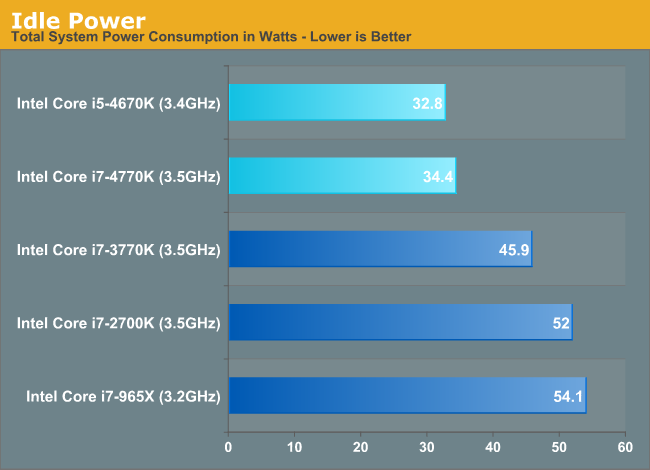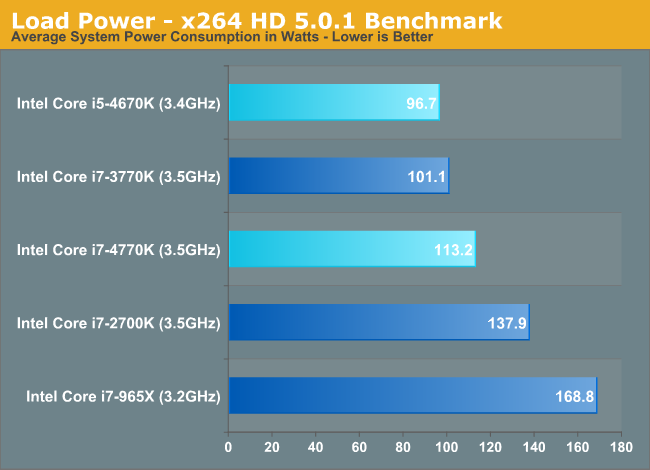The Haswell Review: Intel Core i7-4770K & i5-4670K Tested
by Anand Lal Shimpi on June 1, 2013 10:00 AM ESTPower Improvements
Although Haswell’s platform power is expected to drop considerably in mobile, particularly with Haswell U and Y SKUs (Ultrabooks and ultrathins/tablets), there are benefits to desktop Haswell parts as well.
There’s more fine grained power gating, lower chipset power and the CPU cores can transition between power states about 25% quicker than in Ivy Bridge - allowing the power control unit to be more aggressive in selecting lower power modes. We’ve also seen considerable improvements on lowering platform power consumption at the motherboard level as well. Using ASUS’ Z77 Deluxe and Z87 Deluxe motherboards for the Haswell, Ivy and Sandy Bridge CPUs, I measured significant improvements in idle power consumption:

These savings are beyond what I’d expect from Haswell alone. Intel isn’t the only one looking to make things as best as can be in the absence of any low hanging fruit. The motherboard makers are aggressively polishing their designs in order to grow their marketshare in a very difficult environment.
Under load, there’s no escaping the fact that Haswell can burn more power in pursuit of higher performance:

Here I’m showing an 11.8% increase in power consumption, and in this particular test the Core i7-4770K is 13% faster than the i7-3770K. Power consumption goes up, but so does performance per watt.
The other big part of the Haswell power story is what Intel is calling FIVR: Haswell’s Fully Integrated Voltage Regulator. Through a combination of on-die and on-package circuitry (mostly inductors on-package), Haswell assumes responsibility of distributing voltages to individual blocks and controllers (e.g. PCIe controller, memory controller, processor graphics, etc...). With FIVR, it’s easy to implement tons of voltage rails - which is why Intel doubled the number of internal voltage rails. With more independent voltage rails, there’s more fine grained control over the power delivered to various blocks of Haswell.
Thanks to a relatively high input voltage (on the order of 1.8V), it’s possible to generate quite a bit of current on-package and efficiently distribute power to all areas of the chip. Voltage ramps are 5 - 10x quicker with FIVR than with a traditional on-board voltage regulator implementation.
In order to ensure broad compatibility with memory types, there’s a second input voltage for DRAM as well.
FIVR also comes with a reduction in board area and component cost. I don’t suppose this is going to be a huge deal for desktops (admittedly the space and cost savings are basically non-existent), but it’ll mean a lot for mobile.
No S0ix for Desktop
You’ll notice that I didn’t mention any of the aggressive platform power optimizations in my sections on Haswell power management, that’s because they pretty much don’t apply here. The new active idle (S0ix) states are not supported by any of the desktop SKUs. It’s only the forthcoming Y and U series parts that support S0ix.










210 Comments
View All Comments
klmccaughey - Monday, June 3, 2013 - link
AMD are a damn sight closer on Nvidia than they are to Intel, though still sandbagging for this year. It's a bad year for us upgraders!aCuria - Saturday, June 1, 2013 - link
This review needs a compilation speed test against the 3930k, I would really like to know if haswell could edge out the 3930k in that testKevin G - Saturday, June 1, 2013 - link
Haswell met expectations in terms of IPC increases and power reductions. Both of those are good things overall. However, I feel disappointed and that comes down to how Intel has segregated their product line up: GT3e and TSX are only available on select parts. Ideally on the high end I'd like to get a socketed chip with an unlocked multiplier, GT3e, TSX, and Hyperthreading. Of those five criteria, at best I can get three of those. I suspect that this is due to Intel keeping several possible configurations reserved for their Xeon lineup but those chips won't have an unlocked multiplier.I'm currently an owner of a Sandybridge i7-2600K and the current performance of the Haswell parts aren't that tempting to jump the configurations Intel is selling. So I'm left waiting another year for a future desktop refresh before making the jump. Oh wait, Broadwell is going to be strictly a mobile refresh (and possibly a desktop BGA) refresh. So the best upgrade path for me for the next couple of years is to wait for a cheap i7-3770K on clearance. Otherwise the price/performance gains are radically higher as to not be worth it (also would need to get a new motherboard for socket 1150). I guess I'm left waiting for Skylake, get lucky that Intel adds several SKU's that I want or see what AMD can produce for the desktop.
Khato - Saturday, June 1, 2013 - link
Just curious as to your source for TSX only being available on select parts? The only place I saw that was on the Tom's Hardware preview. It's not in any of the reviews that I've seen?amock - Saturday, June 1, 2013 - link
According to http://ark.intel.com/products/75123/Intel-Core-i7-... the 4770k doesn't have TSX support.Kevin G - Saturday, June 1, 2013 - link
Intel is likely keeping TSX away from any desktop part with eDRAM. I suspect that having a massive L4 cache and TSX may make these quadcore chips very competitive with some of their socket 2011 parts based upon Sandy bridge/Ivy Bridge cores. These would happen in heavily memory bound applications like some database operations tend to be. Intel hasn't updated ARK with all of the Haswell chips yet so I'm be curious to see if their will be a mobile part with GT3e + TSX. I'd love it if some enterprise DB's supporting TSX were tested on this platform to see if this idea pans out.smilingcrow - Saturday, June 1, 2013 - link
The i5/i7 K series socketed desktop chips don't have eDRAM anyway so that's a moot point; they both lack TSX support.Kevin G - Monday, June 3, 2013 - link
Well it does look like that the L4 cache in GT3e parts can make Haswell competitive with socket 2011 six core chips. Check out the i7 4950hq results from Tech Report's Euler 3D fluid dynamics tests:http://techreport.com/review/24879/intel-core-i7-4...
The i7 4950 was likely seeing a strong benefit from an open air test bed (it is a mobile part) so I suspect that it can reach its 3.4 Ghz four core turbo relatively often. I still would expect slightly better performance if the 2.4 Ghz base clock was raised. The i7 4950 is further handicapped as the L3 cache was cut down to 6 MB and was using SO-DIMM memory with loose timings. The kicker is that this is with legacy code with any AVX2, FMA or TSX benefits.
I really, really want an unlocked, noncripppled socket 1150 part with GT3e.
just4U - Sunday, June 2, 2013 - link
Well.. your already on a i7.. and tbh I'd say the 2600K is better than the 3770K. .I purchased a 2700K even though the 3770K was out. Why? Well.. lower heat and miniscule gains in the 3X line.. plus when I decide to OC I'll likely get more out of my chip (as will you..) than they get on the IvyBridge processors.Kevin G - Monday, June 3, 2013 - link
I currently have my i7 2600K running at a conservative 4.2 Ghz. I've gotten it to boot at 4.6 Ghz with ease and probably could go further if felt like increasing voltages and got better cooling (though it is in a 4U server case so cooling options are a bit more limited).Price drops are happening for the i7 3770K. Probably need to wait a bit more and might pick one up if they drop further. Microcenter has dropped them to $230 already.